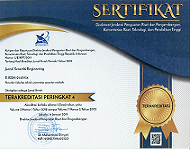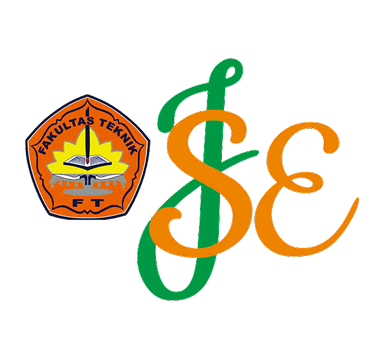Pemetaan Transparansi Air di Waduk Saguling dengan Menggunakan ANN dan Landsat 8
Keywords:
Artificial Neural Network, Penginderaan Jauh, Machine Learning, Transparansi, Waduk SagulingAbstract
The decline in water transparency in the Saguling Reservoir indicates deteriorating water quality due to increasing pollutant loads from domestic, industrial, agricultural, and aquaculture activities. This study aims to predict water transparency using an ANN model, integrating remote sensing data from Landsat 8 (2013-2024) and in-situ measurements from 12 sampling points. The analysis began with correlation tests, which revealed weak to moderate relationships between transparency and other variables. Subsequent simple and multiple linear and logistic regression analyses produced weak correlations, with the highest R² of 0.1853 observed in multiple logistic regression. The Random Forest algorithm was applied to identify the most influential variables. The selected predictors included Bands 3, 4, 5, and 7, as well as temperature, EC, and TSS. These variables were used as inputs for the ANN model, which demonstrated high performance with an R² of 0.8514, explaining 85.14% of the variability in water transparency. The prediction results were visualized in a distribution map, indicating a predominance of transparency class IV (0-2.5 m) across the reservoir. This suggests limited light penetration due to high pollutant loads. The study shows that integrating remote sensing and ML enables effective large-scale water quality monitoring and supports sustainable water resource management.
References
[1] Kementerian Pekerjaan Umum dan Perumahan Rakyat, “Peraturan Menteri Pekerjaan Umum dan Perumahan Rakyat Nomor 04/PRT/M/2015 Tahun 2015 tentang Kriteria dan Penetapan Wilayah Sungai,” 2015.
[2] L. Feng, X. Hou, and Y. Zheng, “Monitoring and Understanding The Water Transparency Changes of Fifty Large Lakes On The Yangtze Plain Based On Long-Term MODIS Observations,” Remote Sens Environ, vol. 221, pp. 675–686, Feb. 2019, doi: 10.1016/j.rse.2018.12.007.
[3] D. Yu, T. Qi, L. Yang, Y. Zhou, C. Zhao, and S. Pan, “Monitoring Water Clarity Using Landsat 8 Imagery in Jiaozhou Bay, China, From 2013 to 2022,” IEEE J Sel Top Appl Earth Obs Remote Sens, vol. 17, pp. 1938–1948, 2024, doi: 10.1109/JSTARS.2023.3340438.
[4] E. Wardhani, S. Notodarmojo, and D. Roosmini, “Sediment Quality Assesment by Using Geochemical Index at Saguling Reservoir West Java Province Indonesia,” Energy and Environment Research, vol. 8, no. 2, p. 34, Nov. 2018, doi: 10.5539/eer.v8n2p34.
[5] N. T. J. Ong and S. K. Yee, “Review on water quality monitoring technologies,” Indonesian Journal of Electrical Engineering and Computer Science, vol. 18, no. 3, pp. 1416–1423, 2020, doi: 10.11591/ijeecs.v18.i3.pp1416-1423.
[6] S. Geetha and S. Gouthami, “Internet of things enabled real time water quality monitoring system,” Smart Water, vol. 2, no. 1, Dec. 2016, doi: 10.1186/s40713-017-0005-y.
[7] M. Zhu et al., “A review of the application of machine learning in water quality evaluation,” Jun. 01, 2022, Elsevier B.V. doi: 10.1016/j.eehl.2022.06.001.
[8] H. Yang, J. Kong, H. Hu, Y. Du, M. Gao, and F. Chen, “A Review of Remote Sensing for Water Quality Retrieval: Progress and Challenges,” Remote Sens (Basel), vol. 14, no. 8, Apr. 2022, doi: 10.3390/rs14081770.
[9] M. A. Chowdhury et al., “Recent Machine Learning Guided Material Research - A Review,” Computational Condensed Matter, vol. 29, p. e00597, Dec. 2021, doi: 10.1016/j.cocom.2021.e00597.
[10] W. Wijayasari, F. I. W. Rohmat, and S. Viridi, “Malaccha: An R-based end-to-end Markov transition matrix extraction for land cover datasets,” SoftwareX, vol. 21, p. 101315, Feb. 2023, doi: 10.1016/J.SOFTX.2023.101315.
[11] Y. Liao, Y. Li, J. Shu, Z. Wan, B. Jia, and Z. Fan, “Water transparency prediction of plain urban river network: A case study of yangtze river delta in china,” Sustainability (Switzerland), vol. 13, no. 13, Jul. 2021, doi: 10.3390/su13137372.
[12] E. S. Salami, M. Salari, M. Ehteshami, N. T. Bidokhti, and H. Ghadimi, “Application Of Artificial Neural Networks And Mathematical Modeling For The Prediction Of Water Quality Variables (Case Study: Southwest Of Iran),” Desalination Water Treat, vol. 57, no. 56, pp. 27073–27084, Dec. 2016, doi: 10.1080/19443994.2016.1167624.
[13] A. Sarkar and P. Pandey, “River Water Quality Modelling Using Artificial Neural Network Technique,” Aquat Procedia, vol. 4, pp. 1070–1077, 2015, doi: 10.1016/j.aqpro.2015.02.135.
[14] M. Chaibi, E. M. Benghoulam, L. Tarik, M. Berrada, and A. El Hmaidi, “Machine Learning Models Based on Random Forest Feature Selection and Bayesian Optimization for Predicting Daily Global Solar Radiation,” International Journal of Renewable Energy Development, vol. 11, no. 1, pp. 309–323, Feb. 2022, doi: 10.14710/IJRED.2022.41451.
[15] M. Sahu, A. Shrivastava, D. C. Jhariya, S. Diwan, and J. Subhadarsini, “Evaluation of correlation of physicochemical parameters and major ions present in groundwater of Raipur using discretization,” Measurement: Sensors, vol. 34, p. 101278, Aug. 2024, doi: 10.1016/J.MEASEN.2024.101278.
[16] A. K. J and S. Abirami, “Aspect-based opinion ranking framework for product reviews using a Spearman’s rank correlation coefficient method,” Inf Sci (N Y), vol. 460–461, pp. 23–41, Sep. 2018, doi: 10.1016/j.ins.2018.05.003.
[17] G. Zhao et al., “Spearman rank correlations analysis of the elemental, mineral concentrations, and mechanical parameters of the Lower Cambrian Niutitang shale: A case study in the Fenggang block, Northeast Guizhou Province, South China,” J Pet Sci Eng, vol. 208, Jan. 2022, doi: 10.1016/j.petrol.2021.109550.
[18] G. M. Fitzmaurice, “Regression,” Diagn Histopathol, vol. 7, no. 22, pp. 271–278, 2016.
[19] J. C. Stoltzfus, “Logistic Regression: A Brief Primer,” Academic Emergency Medicine, vol. 18, no. 10, pp. 1099–1104, Oct. 2011, doi: 10.1111/j.1553-2712.2011.01185.x.
[20] S. R. Shams, A. Jahani, S. Kalantary, M. Moeinaddini, and N. Khorasani, “The evaluation on artificial neural networks (ANN) and multiple linear regressions (MLR) models for predicting SO2 concentration,” Urban Clim, vol. 37, May 2021, doi: 10.1016/j.uclim.2021.100837.
[21] X. Lu, S. Y. Teh, C. J. Tay, N. F. Abu Kassim, P. S. Fam, and E. Soewono, “Application of Multiple Linear Regression Model and Long Short-Term Memory with Compartmental Model to Forecast Dengue Cases in Selangor, Malaysia Based on Climate Variables,” Infect Dis Model, vol. 10, no. 1, pp. 240–256, Mar. 2025, doi: 10.1016/j.idm.2024.10.007.
[22] J. H. McDonald, “Multiple Logistic Regression,” Libre Texts Statistics. Accessed: Mar. 28, 2025. [Online]. Available: https://stats.libretexts.org/Bookshelves/Applied_Statistics/Biological_Statistics_(McDonald)/05%3A_Tests_for_Multiple_Measurement_Variables/5.07%3A_Multiple_Logistic_Regression
[23] T. Vakili and J. Amanollahi, “Determination of Optically Inactive Water Quality Variables Using Landsat 8 Data: A Case Study in Geshlagh Reservoir Affected by Agricultural land Use,” J Clean Prod, vol. 247, Feb. 2020, doi: 10.1016/j.jclepro.2019.119134.
[24] T. M. Tung and Z. M. Yaseen, “A Survey On River Water Quality Modelling Using Artificial Intelligence Models: 2000–2020,” J Hydrol (Amst), vol. 585, Jun. 2020, doi: 10.1016/j.jhydrol.2020.124670.
[25] A. Shamloo and S. Sima, “Investigating the potential of remote sensing-based machine-learning algorithms to model Secchi-disk depth, total phosphorus, and chlorophyll-a in Lake Urmia,” J Great Lakes Res, vol. 50, no. 4, p. 102370, Aug. 2024, doi: 10.1016/j.jglr.2024.102370.
[26] L. Kumar, M. S. Afzal, and A. Ahmad, “Prediction of water turbidity in a marine environment using machine learning: A case study of Hong Kong,” Reg Stud Mar Sci, vol. 52, May 2022, doi: 10.1016/j.rsma.2022.102260.
[27] E. S. Leggesse, F. A. Zimale, D. Sultan, T. Enku, R. Srinivasan, and S. A. Tilahun, “Predicting Optical Water Quality Indicators from Remote Sensing Using Machine Learning Algorithms in Tropical Highlands of Ethiopia,” Hydrology, vol. 10, no. 5, May 2023, doi: 10.3390/hydrology10050110.
[28] C. Ciaburro and B. Venkateswaran, Neural Network with R: Smart Models Using CNN, RNN, Deep Learning, and Artificial Intelligence Principles. Birmingham: Packt Publishing Ltd, 2017.
[29] A. Jahani, S. Kalantary, and A. Alitavoli, “An application of artificial intelligence techniques in prediction of birds soundscape impact on tourists’ mental restoration in natural urban areas,” Urban For Urban Green, vol. 61, p. 127088, Jun. 2021, doi: 10.1016/j.ufug.2021.127088.
[30] M. Saffariha, A. Jahani, and D. Potter, “Seed germination prediction of Salvia limbata under ecological stresses in protected areas: an artificial intelligence modeling approach,” BMC Ecol, vol. 20, no. 1, p. 48, Dec. 2020, doi: 10.1186/s12898-020-00316-4.
[31] Pemerintah Republik Indonesia, “Peraturan Pemerintah Nomor 22 Tahun 2021 tentang Penyelenggaraan Perlindungan dan Pengelolaan Lingkungan Hidup,” 2021
[32] Sukatmo, H. A. Nugroho, B. H. Rusanto, and S. Soekirno, “Performance Comparison of 1D-CNN and LSTM Deep Learning Models for Time Series-Based Electric Power Prediction,” ELKOMIKA: Jurnal Teknik Energi Elektrik, Teknik Telekomunikasi, & Teknik Elektronika, vol. 13, no. 1, p. 44, Feb. 2025, doi: 10.26760/elkomika.v13i1.44.
[33] F. I. W. Rohmat, J. W. Labadie, and T. K. Gates, “Deep learning for compute-efficient modeling of BMP impacts on stream- aquifer exchange and water law compliance in an irrigated river basin,” Environmental Modelling and Software, vol. 122, Dec. 2019, doi: 10.1016/j.envsoft.2019.104529.
Downloads
Published
Issue
Section
License
Copyright (c) 2025 Azzahra Magfhira, Prayatni Soewondo, Winda Wijayasari, Faizal Rohmat (Author)

This work is licensed under a Creative Commons Attribution 4.0 International License.












